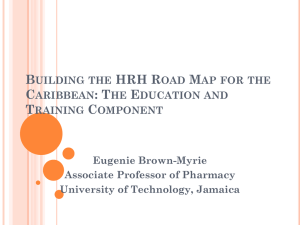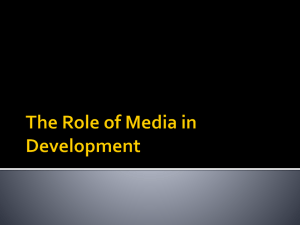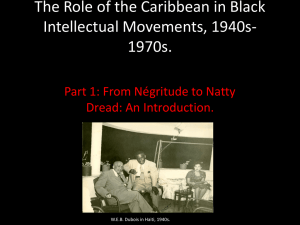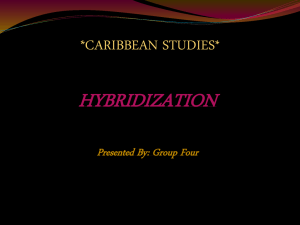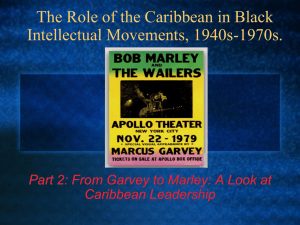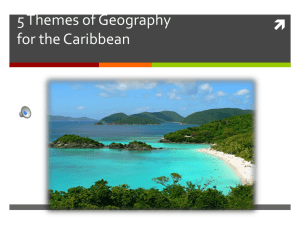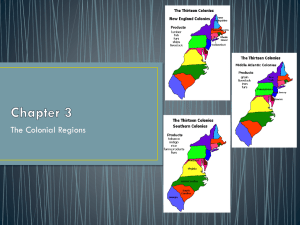A. Anthony Chen - Uwi.edu - University of the West Indies
advertisement
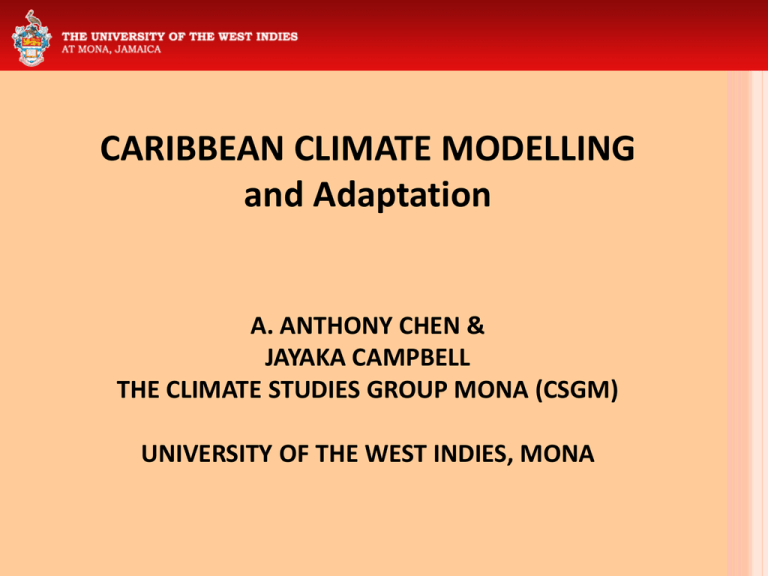
CARIBBEAN CLIMATE MODELLING and Adaptation A. ANTHONY CHEN & JAYAKA CAMPBELL THE CLIMATE STUDIES GROUP MONA (CSGM) UNIVERSITY OF THE WEST INDIES, MONA OUTLINE Before 2007 Climate Modelling Importance of modelling Early Works 2007 – IPCC 4th Assessment After 2007 Some Results Current • Future Work 2 CLIMATE Defining key terms Climate “average weather” over period of ~ 30 years usually. Climate Change A significant change from one climatic condition to another Due to natural or anthropogenic causes. 3 Climate Modelling is important Atmosphere is too vast Impossible to carry out large scale experiments Climate simulation or modelling is the only way to study large scale systems of the atmosphere Climate models are an important tool for scientists to understand the complexities of Earth’s climate incorporate both theory and direct observations of the past and present in order to project climate into the future Lay the foundation for decision making concerning climate change Climate Models Introducing key tools Dynamic Climate Model Equations describing processes Types General Circulation Models – GCM’s Regional Climate Models – RCM’s Domain –Region over which RCM works Statistical Downscaling Models Reducing GCM to finer scale by use of statistical relationships between atmospheric parameters and climate variables Require ~ 30 years of daily data 5 Dynamic Computer Models Solves for/calculates and steps forward in time • Equations of motion • First law of thermodynamics • Physics of water vapor and clouds •Chemical processes in atmosphere • Land - atmosphere interactions Biological processes • Land - ocean interactions Distinction between GCM and RCM GCM Resolution are too coarse to identify small islands (Boxes too large) RCMs have finer resolution (Smaller boxes) 7 Jamaica as an example GCM – 2 grid boxes RCM – 10 grid boxes Use Scenarios for Climate Change Studies Plausible future climate based on perceived greenhouse gas emission which depend on developments in Demographics Technology Economics Special Report on Emission Scenarios (SRES) SRES Scenarios can be classified into four family groups further divided into scenario groups. 9 SRES FAMILY TREE • Roots are the drivers • Population • Economy • Technology • Etc • Branches depend on whether development is • globally intergated or regional • Driven by economics or environmental considerations Source : http://www.grida.no/climate/ipcc/emission/ 10 SRES S CENARIOS Source : http://www.grida.no/climate/ipcc/emission/spm-3.htm 11 CARIBBEAN CLIMATE MODELLING INITIATIVE 2002 CSGM along with other Caribbean partners (INSMET – Cuba, UWI Cavehill – Barbados and CCCCC – Belize) begun Caribbean modelling initiative Deliberate collaborative effort to produce Caribbean climate projections at scale of Caribbean. Premised on shared workload to get results out quickly. Premised on building of capacity in the region. Multiple components to the strategy, but concentrate on a major one. EARLY WORKS – 2002 CLIMATE MODELLING INITIATIVE Introduction a Regional Climate Model PRECIS - Providing REgional Climates for Impact Studies • Hadley Centre, UK • • • • • • • Dynamical Downscaling Model (RCM) Can be used for any part of the Globe Has a resolution of up to 25km Driven by full suite of physics Multiple variables on multiple levels in atmosphere. Forced at its boundaries by other GCMs - the HADAM3P GCM and ECHAM. Built by UK Hadley Centre but run locally PRECIS Modelling • Complex but computationally less expensive than a GCM. • Requires a Desktop Standard Desktop Pentium 4 Processor • Could be run locally EARLY WORKS – CLIMATE MODELLING INITIATIVE DOMAIN • Big Domain including all Caribbean, Central America, southern USA and northern South America. Run at 50 km Two smaller domains: • Western & Eastern Caribbean (yellow and red enclosure) at 25 km EARLY WORKS – CLIMATE MODELLING INITIATIVE PRECIS Workload Shared Cuba Carib basin (INSMET) 50 x 50 km Jamaica – UWI (Mona) Carib Basin Barbados – UWI (Cave Hill) Eastern Caribbean A2 (30 yrs) & B2 (30 yrs) 25 x 25 km Baseline (30 yrs) Belize - 5C’s Caribbean and Eastern Caribbean Multiple runs 50 x 50 km B1 (30 yrs) & A2 (30 yrs) Baseline (30 yrs) Reanalysis (15 yrs) A2 (30 yrs) & B2 (30 yrs) Baseline (30 yrs) Baseline (1961 – 1990), Reanalysis (1979 – 1993), A2 & B2 (2071 – 2100) E ARLY W ORKS – M ODEL V ALIDATION Precipitation (A) Rainfall Early season April – June Late season August November Temperature (B) General temperature Pattern Captured 16 E ARLY W ORKS – M ODEL P ROJECTIONS A2 General tendency for drying (main Caribbean basin) by end of the century. Drying between 25% and 30% B2 Mean changes in the annual rainfall for 2071-2099 with respect to 1961-1990, as simulated by PRECIS_ECH and PRECIS_Had for SRESA2 and SRESB2. Possibly wetter far north Caribbean NDJ and FMA. Drying exceeds natural variability June-October – wet season dryer! E ARLY W ORKS – M ODEL P ROJECTIONS Precipitation Natural Variability 18 E ARLY W ORKS – M ODEL P ROJECTIONS Projected Precipitation Change General tendency for drying (main Caribbean basin) by end of the century. Drying between 25% and 30% Possibly wetter far north Caribbean NDJ and FMA. Drying exceeds natural variability June-October – wet season dryer! 19 E ARLY W ORKS – M ODEL P ROJECTIONS A2 Irrespective of scenario the Caribbean expected to warm. Warming between 1 and 5oC B2 Mean changes in the annual mean surface temperature for 2071-2099 with respect to 1961-1990, as simulated by PRECIS_ECH & PRECIS_Had for SRESA2 and SRESB2. Warming greater under A2 scenario. Warming consistent with projections for other parts of globe. Warming far exceeds natural variability E ARLY W ORKS – M ODEL P ROJECTIONS Temperature Natural Variability 21 E ARLY W ORKS – M ODEL P ROJECTIONS Projected Temperature Change 22 Not Reported in IPCC (2007) Unable to report results until 2007 due to amount of work involved. Not reported in IPCC 2007 4th Assessment IPCC 2007 4th Assessment mentioned: a) GCM work done at UPR Mayaguez: Angeles, M.E., J.E. Gonzalez, D.J. Erickson, and J.L. Hernández, 2007: Predictions of future climate change in the Caribbean region using global general circulation models Int. J. Climatol., 27, 555-569 b) Work done on statistical downscaling at UWI, Mona: http://www.aiaccproject.org IPCC Fourth Assessment 2003 – 2006 Published in 2007 Working Group 1 Report: The Physics Science Basis (Data Analysis & Climate Modelling) Working Group II Report: Impacts, Adaptation and Vulnerability Working Group III Report "Mitigation of Climate Change" NOT ENOUGH REGIONAL MODELLING DONE FOR THE CARIBBEAN o Report based on course General Circualtion models Temperature Changes under A1B Scenario 1980-1999 to 2080-2099 Temperature Changes under A1B Scenario 1980-1999 to 2080-2099 Rainfall Changes under A1B Scenario 1980-1999 to 2080-2099 Rainfall Changes Changes under A1B Scenario 19801999 to 2080-2099 After 2007- A Few Publications – Modelling Initiative Taylor MA, A Centella, J Charlery, I Borrajero , A Bezanilla, J Campbell, R Rivero, TS Stephenson, F Whyte, R Watson, 2007. Glimpses of the Future: A Briefing from the PRECIS Caribbean Climate Change Project, Caribbean Community Climate Change Centre, Belmopan, Belize. Campbell J, MA Taylor, TS Stephenson, RA Watson, FS Whyte, 2010: Future Climate of the Caribbean from a Regional Climate Model. Int J Climatol DOI: 10.1002/joc.2200. Other reports: Cashman, A., L. Nurse, and J. Charlery. 2010. Climate change in the Caribbean: The water management implications. The Journal of Environment & Development 19(1): 42-67. Charlery, J., and L. Nurse. 2010. Areal downscaling of global climate models: an approach that avoids data remodelling. Clim Res 43: 241–249. doi: 10.3354/cr00875. After 2007 – USE OF DATA Reporting Purposes St. Lucia RCM RCM Compiling projections for use in 2nd National Communications: Antigua St. Lucia St. Vincent Grenada Jamaica 2070s 2070s JAN 1.6 - 1.9 JAN -46.91 --25.90 FEB 1.8 - 2.3 FEB -78.37 - -50.04 MAR 1.9 - 2.5 MAR -86.14 - -50.95 APR 1.9 - 2.8 APR -81.80 - -57.79 MAY 2.2 - 2.7 MAY -69.91 - -47.49 JUN 2.1 - 2.7 JUN -77.10 - -47.26 JUL 1.9 - 2.5 JUL -57.86 - -29.02 AUG 1.9 - 2.2 AUG -36.29 - -21.95 SEP 2.0 - 2.2 SEP -39.94 - -21.95 OCT 1.9 - 2.3 OCT -33.13 - -3.76 NOV 1.8 - 2.1 NOV -30.37 - +18.58 DEC 1.8 - 2.1 DEC -48.69 - -8.32 ANNU AL 1.9 - 2.4 ANNUAL -57.21 - -27.94 Temps Rainfall MORE RECENT – PILOT PROJECT FOR CLIMATE RESILIENCE (PPCR) Climatology, Trends, Projections and Impacts for Jamaica Funded by adaptation and mitigation funds following Copenhagen and Cancun PPCR – the first program developed and operational under the Strategic Climate Fund (SCF), SCF one of two funds within the design of the Climate Investment Funds (CIF) 31 CURRENT & Future – MODELLING INITIATIVE Uncertainies in model results Increase confidence limits by averaging the results of many models Expand range of RCMs PRECIS WRF REMO CCSM Use of high resolution GCM (Japanese 20 km model) C URRENT – M ODELLING I NITIATIVE Investigating Hurricane* like vortices present in climate models. Model WRF - H 33 C URRENT – M ODELLING I NITIATIVE Addition of the Japanese MRI Earth Simulator model results GCM Horizontal resolution 20km 24 Levels of atmosphere 26 Variables (16 surface, 10 3D) All variables are monthly averages GCM model with highest resolution so far 34 J APANESE M ODEL R ESULTS T OPOGRAPHY C URRENT – M ODELLING I NITIATIVE Diagram shows how accurately the 20 km JMA/MRI Model represents topographical heights. GTOPO30 - observed topographical heights. 20, 60, 120 and 180 km model simulations Note : Above 60 Km even the mountains of larger territory of Hispaniola aren’t simulated 35 CURRENT – MODELLING INITIATIVE J APANESE M ODEL R ESULTS T OPOGRAPHY Looking at Western Caribbean mountains (Belize) from South to North, 20 km resolution better than 60, 120, 180 Diagram the comparison of Grey blocks (GTOPO30 - observed topographical heights) and modeled 20, 60, 120 and 180 km simulations of cross-section for particular latitudes 36 F UTURE – M ODELLING I NITIATIVE Past & Current work offers a first look at the possibilities for the future of Caribbean climate. However we need to: Expand the range of forcing GCMs of the PRECIS model from HADCM3 and ECHAM5 Incorporate more RCMs to add a greater degree of confidence to generated projections. Move from atmosphere only models to ones with a coupled ocean-atmosphere framework Run a full ensemble of climate modelling scenarios, not just the extremes in each case. More Statistical downscaling 37 Future - Analysis of Model Results using Representative Concentration Pathways (RCP) for IPCC 5th Radiative forcing: measure of difference between incoming and outgoing radiation in the atmosphere Representative concentration pathways. Image 2.6 emissions will restrict temperature rise to 2ºC RH Moss et al. Nature 463, 747-756 (2010) doi:10.1038/nature08823 F UTURE – M ODELLING & OTHER SECTORS Form closer relationship with the Impact and Adaptation community. Climate Impacts our daily life; How do we adapt? The Caribbean is heavily dependent on agriculture and tourism, so what is the significance of a projected 1ºC – 5ºC rise in temperature to those sectors? What do the projected changes mean for the onset or spread of tropical diseases (examples .. dengue or leptospirosis)? How or will the projected changes in climate impact development and plannning? 39 F UTURE More Partnerships Too difficult, time consuming for any one country or institution. Collaboration heightens efficiency for producing usable results. Builds synergies/support groups across institutions. End-Note Climate affects all aspects of life (Taylor, 2010) Climate change is a threat to all life Concern of all our government ministries, private sector organizations and civil society With no global accord on the reduction of GHGs, threat of climate change will become very severe the cost of adapting, especially to sea level rise, will become enormous future prosperity of the Caribbean community will be at risk. Thank You Climate Studies Group Mona
